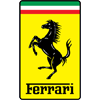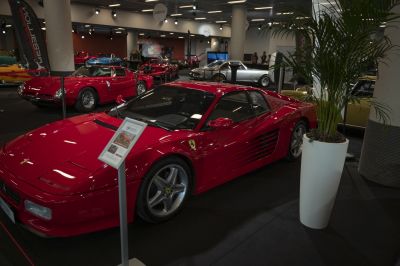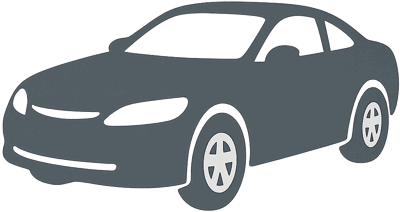 1985 Ferrari Testarossa Dimensions, Size & Specs
1985 Ferrari Testarossa Dimensions, Size & SpecsMeasurements of the 1985 Ferrari Testarossa, engineered for optimal performance and comfort
| Dimensions | |
|---|---|
| Length: | 4485 mm176.6 in14.7 ft |
| Width: | 1975 mm77.8 in6.5 ft |
| Height: | 1130 mm44.5 in3.7 ft |
| Weight Specifications | |
| Curb Weight: | 1700 kg3748 lbs |
| Maximal permitted Weight: | 1900 kg4189 lbs |
| Tire Specifications | |
| Tire Sizes: |
|
The Ferrari Testarossa, produced from 1984 to 1992, is one of the most iconic sports coupes of its era, blending dramatic design with powerful performance. This 1985 generation represents the classic Testarossa model, famous for its distinctive wide stance and aggressive styling. The car measures 4485 mm (176.6 inches) in length, providing a compact yet purposeful footprint characteristic of high-performance sports cars of the 1980s. It boasts a substantial width of 1975 mm (77.8 inches), which enhances stability and road presence while emphasizing its muscular profile. Standing at a low height of just 1130 mm (44.5 inches), the Testarossa offers a low center of gravity, which contributes to superior handling and driving dynamics. With a curb weight of 1700 kg (3748 lbs), the vehicle balances weight and agile performance, while its maximum weight of 1900 kg (4189 lbs) indicates its capacity with passengers and cargo. Tire sizes of 225/50 R16 at the front and 255/50 R15 at the rear reflect the car’s focus on grip and balanced handling characteristics. Overall, the Ferrari Testarossa is celebrated for its combination of iconic design, distinctive size proportions, and engineering excellence that set a benchmark in the coupe sports car segment through the late 1980s and early 1990s.
Discover the standout features that make the 1985 Ferrari Testarossa a leader in its class
Have a question? Please check our knowledgebase first.
The Ferrari Testarossa from the 1985 generation measures 4485 mm (176.6 inches) in length, 1975 mm (77.8 inches) in width, and stands at 1130 mm (44.5 inches) in height. These dimensions give it a wide and low stance, emphasizing its sporty and aggressive design typical for a high-performance coupe of the 1980s.
With a width of 1975 mm (77.8 inches) and a height of only 1130 mm (44.5 inches), the Ferrari Testarossa has a low and wide profile that enhances its stability and grip during high-speed cornering. The broad track increases road presence making it distinguishable, while the low height reduces aerodynamic drag, contributing to improved handling and performance on the road.
The curb weight of the Ferrari Testarossa is approximately 1700 kg (3750 lbs). For a mid-1980s supercar, this weight is reasonable considering its powerful V12 engine and robust construction. A moderate weight like this balances acceleration, braking, and handling, enabling the Testarossa to perform with agility while maintaining its grand touring comfort.
The Ferrari Testarossa is fitted with 225/50 R16 tires on the front and 255/50 R15 tires on the rear. These staggered tire sizes enhance traction and handling by providing a larger contact patch at the rear to manage the power delivery of the mid-mounted V12 engine, while the slightly narrower front tires improve steering precision and feedback.
While the Ferrari Testarossa is primarily designed for performance and style, it offers modest cargo space typical of a mid-engine coupe. The front trunk (frunk) and limited rear compartment provide enough room for small luggage or essentials. It's adequate for short road trips but not designed for large cargo loads, emphasizing the car's sportscar focus over utility.
The Ferrari Testarossa's dimensions are 4485 mm long and 1975 mm wide (176.6 x 77.8 inches), which fit most standard single-car garages with typical clearances. However, because the car is quite wide compared to average sedans, precision parking is required to avoid side clearance issues. The low height (1130 mm or 44.5 inches) presents no challenges entering garages with standard ceiling heights.
Compared to its predecessor, the Ferrari Berlinetta Boxer (BB), the Testarossa is slightly longer and wider. The BB was shorter at roughly 4350 mm (171.3 inches) in length and narrower at about 1795 mm (70.7 inches) wide. The Testarossa's increased width (1975 mm or 77.8 inches) gave it a more aggressive stance and improved interior space, while both cars share a low height around 1100-1130 mm, maintaining a low-slung design ethos.
Compared to contemporaries like the Lamborghini Countach or Porsche 911 (930 generation), the Testarossa is wider but not necessarily longer. The Countach is similar in length but typically narrower, while the 911 is smaller overall in all dimensions. The Testarossa’s width (1975 mm) and low height (1130 mm) give it a broad, squat appearance that emphasizes high-speed stability, distinguishing it within the supercar class of the 1980s.
The 1985 Ferrari Testarossa is renowned for its mid-mounted 4.9-liter flat-12 engine producing around 390 horsepower, allowing a top speed exceeding 290 km/h (180 mph). It features distinctive side strakes, a luxurious interior for its era, and advanced engineering like independent suspension and a 5-speed manual gearbox. Its combination of performance, style, and grand touring capability has cemented its status as an iconic 1980s supercar.
The Ferrari Testarossa has a curb weight of about 1700 kg (3750 lbs) and a maximum permissible weight of approximately 1900 kg (4189 lbs). This means the car can carry an additional 200 kg (439 lbs) of passengers, cargo, and fuel, which is typical for a high-performance sports coupe. Staying within these limits is important to maintain safety, handling precision, and overall performance.
Discover similar sized cars.
| Production: | 1994-1996 |
|---|---|
| Model Year: | 1995 |
| Length: | 4480 mm176.4 in |
| Width: | 1976 mm77.8 in |
| Height: | 1135 mm44.7 in |

| Production: | 1992-1994 |
|---|---|
| Model Year: | 1992 |
| Length: | 4480 mm176.4 in |
| Width: | 1975 mm77.8 in |
| Height: | 1135 mm44.7 in |

| Production: | 2024-present |
|---|---|
| Model Year: | 2024 |
| Length: | 4490 mm176.8 in |
| Width: | 2000 mm78.7 in |
| Height: | 1140 mm44.9 in |
